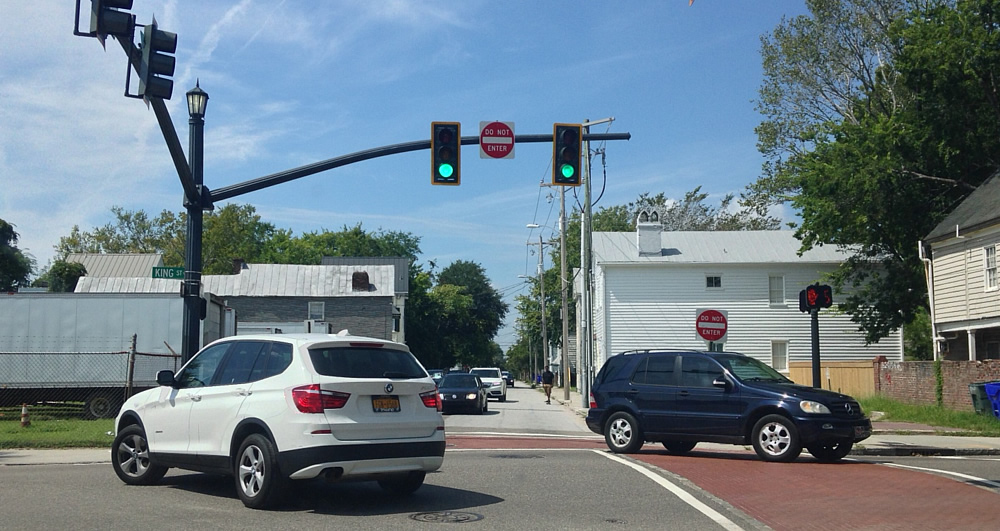 DUMB SIGNAL. What these traffic signals on Line Street facing south at King Street need are green directional arrows, not green lights. That will ensure that spacey drivers — especially those at night who may miss the “Do Not Enter” sign — don’t go straight on what becomes a one-way street on the other side of the signal. Until this is fixed, this intersection is an accident or three waiting to happen.
DUMB SIGNAL. What these traffic signals on Line Street facing south at King Street need are green directional arrows, not green lights. That will ensure that spacey drivers — especially those at night who may miss the “Do Not Enter” sign — don’t go straight on what becomes a one-way street on the other side of the signal. Until this is fixed, this intersection is an accident or three waiting to happen.
IN THIS ISSUE
PHOTO: Dumb signal
FOCUS, Toby Smith: In race to be a voice for the voiceless
BRACK: South Carolina can learn from Cuba
IN THE SPOTLIGHT: Kaynard Photography
MONTHLY: Alzheimer’s session to be Sept. 11
GOOD NEWS: Five library listening sessions scheduled
FEEDBACK: Letters on Cuba trip
CALENDAR: Sept. 7+
REVIEW: Factory Man, by Beth Macy
MYSTERY: Old brick, old gate
S.C. ENCYCLOPEDIA: South Carolina’s connection to Barbados
TODAY’S FOCUS
In race to be a voice for the voiceless
By Toby Smith, candidate for Charleston mayor
SEPT. 7, 2015 | I’m 315 pages into Isabel Wilkerson’s masterpiece, The Warmth of Other Suns. This saga of the Great Migration should be required reading across the board. I see my great grandparents, grandparents and parents, and better understand the economic challenges that continue to be vexing, why the pursuit of education is so very critical for minority populations, and the suffocating impact of bias, discrimination and racism. Frankly, I see myself, my life and the challenges I’ve overcome.
But that’s not the end of the story. One day, in the near future, there will be a sequel about the folks who came back “home” and found things well! We will read about how Charleston reversed the wave of gentrification, created diverse neighborhoods with a range of affordable housing options, and made childhood education a priority so that all kids could get a good job and raise a family in the communities they love. That story is pending, but it can be done and that’s why I entered the race for mayor of Charleston.
I didn’t hear any conversation about gentrification. I want to be the voice that advocates, “But wait, what’s going to happen to these families if you put a new development here? They can’t afford to live here.” I want to be voice of the low-level environmental tech who is living paycheck to paycheck, but desires a step-up job with a livable wage. We do this now at Midland Park Community Ministries: Our employment coordinator has helped nearly 30 people step up to stability. With the booming business community, auto and plane manufacturers, and the tech corridor, there is no reason that more people can’t do the same.
I didn’t hear any conversation about the communities on the edge … you know, the folks who aren’t participating in Charleston’s boom. You know them. The folks who tend to be unengaged because it appears that their voices don’t matter. I want to invite them to the table – beforehand – to discuss the decisions being made about their communities.
 I have a special place in my heart for West Ashley, the WA, my term of affection. My family settled in this area when we returned from Pennsylvania in the mid-70s (that’s 1970s, smile). I’m looking forward to seeing Citadel Mall surpass her former glory. That mall was a jewel back in the day; walking through it now is just pitiful. But we can tackle that. The plans are in place; they are extensive and community-driven. I think about communities being vibrant, viable, valued and valuable. All of Charleston’s neighborhoods have a uniqueness and appeal. Think about Avondale. It’s hip, lively and energetic. I want to see the uniqueness of each neighborhood complement the whole.
I have a special place in my heart for West Ashley, the WA, my term of affection. My family settled in this area when we returned from Pennsylvania in the mid-70s (that’s 1970s, smile). I’m looking forward to seeing Citadel Mall surpass her former glory. That mall was a jewel back in the day; walking through it now is just pitiful. But we can tackle that. The plans are in place; they are extensive and community-driven. I think about communities being vibrant, viable, valued and valuable. All of Charleston’s neighborhoods have a uniqueness and appeal. Think about Avondale. It’s hip, lively and energetic. I want to see the uniqueness of each neighborhood complement the whole.
I love what Charleston has become!
And, in 25 years, my girls, 6, 4 and 3, respectively, will be close to or nearing 30. I’m looking forward to hearing about their well-paying jobs, which they found in Charleston, the homes they are purchasing, in Charleston, their cool and diverse neighbors who appreciate the culture upon which Charleston was built, and the awesome school system that provides for and values all students equally.
It’s all possible and the pieces are already in place. We don’t have to start from scratch. But I need your vote and your heart on November 3. I need you to help me tackle the tough issues that impact our community, many of which are rooted in racial disparities. I want to build a foundation that will support our children, just as my parents, grandparents and great grandparents did for me. Where we are today is not the end of the story and the door is open. Let’s do this. Let’s go through it together.
Toby Smith is a nonprofit consultant and associate minister at Mount Olive Baptist Church in Union Heights. Learn more about her campaign here: http://www.tobysmith.us
EDITOR’S NOTE: Charleston Currents has offered this space to each of the Charleston mayoral candidates to share their views with readers. Click the “2015 Election” tab at top to see pieces by William Dudley Gregorie and Maurice Washington. Next week: Leon Stavrinakis, followed Sept. 21 by Ginny Deerin and Sept. 28 by John Tecklenburg.
COMMENTARYSouth Carolina can learn from Cuba
By Andy Brack, editor and publisher
SEPT. 7, 2015 | For as long as Americans not old enough to be in the AARP have been alive, Cuba has been a pariah, a non-democratic experiment whose embarrassing Soviet connections caused a geo-political chess game.
![]() But as Soviet regimes crumbled in the early 1990s, Cuba was left hanging, still isolated and cut off from its rich neighbor to the north. Cubans literally lost weight, as food became harder to get. But its economic crisis forced institutional changes. The Cuba of today isn’t the Cuba of the Cold War.
But as Soviet regimes crumbled in the early 1990s, Cuba was left hanging, still isolated and cut off from its rich neighbor to the north. Cubans literally lost weight, as food became harder to get. But its economic crisis forced institutional changes. The Cuba of today isn’t the Cuba of the Cold War.
According to Cubans met during a recent visit, one-fifth of the people in the 5 million person labor force have jobs in private businesses from family-owned restaurants to small shops to other tourism-related jobs. Today, Cubans can swap houses if they want to live somewhere else — and have to pay some kind of confusing tax to do so. Sure, the socialist state still provides ration cards for free food for families as well as free education, health care and more. But the country also is changing economically, which eventually should have a positive trade impact with the U.S. as relations thaw.
Without getting into deep discussions over Cuba’s experiment with socialism, South Carolina may be able to learn a little from Cuba’s experiences over the last five decades. Some observations, courtesy participants in a 19-person group tour in August:
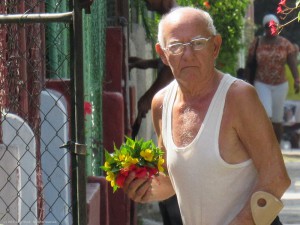 Health care. Cuba’s health care system — particularly its emphasis on high-quality doctors and medical research — has led to some innovations, such as a lung cancer vaccine called Cimavax that’s been free to Cubans since 2011. The treatment offers such promise that N.Y. Gov. Andrew Cuomo went to Havana in April to take a look. Since then, an agreement for clinical trials in the U.S. has been signed.
Health care. Cuba’s health care system — particularly its emphasis on high-quality doctors and medical research — has led to some innovations, such as a lung cancer vaccine called Cimavax that’s been free to Cubans since 2011. The treatment offers such promise that N.Y. Gov. Andrew Cuomo went to Havana in April to take a look. Since then, an agreement for clinical trials in the U.S. has been signed.
Cuba focuses on preventing people from getting diseases and treating them quickly. Doctor-nurse teams live in neighborhoods they serve and know their patients. Health care is coordinated and community-based at a cost that reportedly is 4 percent of what the U.S. pays. Meanwhile, Cubans have the same life expectancy as Americans.
Noted one participant in the tour: “If Cuba has figured out a way to take care of its people, why can’t the biggest economy in the world do it? Societies need to take care of their children.” A lesson for South Carolina: Accept federal Medicaid expansion money so that the poorest of South Carolina’s poor can get access to better health care — medical treatment that focuses on prevention, not expensive emergency treatment.
- Literacy. Cuba, while poor, has a universal public education system that has created a literate population with some 99.8 percent of people older than 14 being able to read and write a short simple statement about everyday life, according to the United Nations. In South Carolina, data indicate literacy rates of about 85 percent. It’s obvious that Cubans are doing something right, at least in early education, that merits a closer look.
- Trash. Cuba seems like a pretty clean country. Maybe it’s because there’s not a fast-food joint on every corner. But there’s also an obvious pride of place that regular people have to keep roads and neighborhoods in urban and rural areas relatively free from trash.
- Agriculture. Perhaps the biggest lesson we can learn is in agriculture, particularly in getting back to basics of our grandparents in growing foods without lots of chemicals or pesticides. Cuba did it out of necessity and it seems to be paying off. After the Soviets, Cuba, just to feed itself, launched a program of urban and family organic gardening to produce more food. Fresh, seasonal foods seem to be widely available. Additionally, there’s apparently a rise in the countryside of small, family farms that produce an array of foods for local restaurants and markets.
One group participant found the focus on neighborhood and small farming to be Cuba’s biggest lesson, noting how he was impressed by “the importance of small family farming and how it can diversify the crop base and reduce the influence of corporate farming.”
There is much to gain from improved relations with Cuba — for us, as much as for them.
MORE ON CUBA:
- Photo essay: The cars of Cuba
- Photo essay: The faces of Cuba
- Commentary: Cuba faces big changes with thaw with U.S.
Andy Brack is editor and publisher of Charleston Currents and Statehouse Report. You can reach him at: editor@charlestoncurrents.com
IN THE SPOTLIGHTKaynard Photography
The public spiritedness of our underwriters allows us to bring Charleston Currents to you at no cost. Today we shine our spotlight on Kaynard Photography, a business run by contributing photographer Michael Kaynard of West Ashle y. Kaynard Photography grew from Michael’s love of walking the streets of the Charleston’s historic district. It developed into a passion for capturing everything Charleston through a camera lens. Kaynard can be seen walking the streets of Charleston many days from dawn to darkness. He calls his work “At Street Level.” His photos are available for viewing and sale at kaynardphotography.com.
y. Kaynard Photography grew from Michael’s love of walking the streets of the Charleston’s historic district. It developed into a passion for capturing everything Charleston through a camera lens. Kaynard can be seen walking the streets of Charleston many days from dawn to darkness. He calls his work “At Street Level.” His photos are available for viewing and sale at kaynardphotography.com.
Now headquartered at 114 East Bay Street in the W. Hampton Brand Gallery across from Rainbow Row in the Charleston Historic District.
MONTHLYAlzheimer’s group to provide day of education on Sept. 11
By Mary Ross McQuage, contributing editor
SEPT. 7, 2015 | The South Carolina chapter of the Alzheimer’s Association on September 11 will host the 14th Annual Educational Workshop entitled “Putting the Pieces Together.” The program will be held from 8:30 a.m. to 3:30 p.m., with lunch provided, at College Center, Trident Technical College Main Campus, at 7000 Rivers Avenue in North Charleston, SC.
 “Putting the Pieces Together” offers education and resources for both family caregivers and professional care providers for persons with Alzheimer’s or related dementia. The program will answer common questions, such as current treatments and research, ways to promote healthy aging, legal concerns, geriatric psychiatry and hospice.
“Putting the Pieces Together” offers education and resources for both family caregivers and professional care providers for persons with Alzheimer’s or related dementia. The program will answer common questions, such as current treatments and research, ways to promote healthy aging, legal concerns, geriatric psychiatry and hospice.
Registration is $20 for a family caregiver or a student, $65 for professionals seeking Contact Hours for continuing education, and $35 for professionals not needing continuing education and all others. Registration is available online at www.alz.org/sc or by calling the Alzheimer’s Association at 800-272-3900. If you are a family caregiver, please call in advance to inquire about accessing complimentary sitter service for a loved one with dementia in order for you to attend.
About the Alzheimer’s Association: The Alzheimer’s Association is the world’s leading voluntary health organization in Alzheimer’s care, support and research. Our mission is to eliminate Alzheimer’s disease through the advancement of research; to provide and enhance care and support for all affected; and to reduce the risk of dementia through the promotion of brain health. For more information, please visit alz.org/sc, or call the 24-Hour Helpline at 800-272-3900.
Mary Ross McQuage, LISW-CP, is a certified Geriatric Care Manager and the owner of Aging Resources, a geriatric care management practice in Charleston.
GOOD NEWSLibrary architects seek input for new branches
The Charleston County Public Library wants you to share your thoughts on what new and renovated libraries, approved overwhelmingly in November in a bond referendum, should be.
 Architects are developing a plan that lists what kind of spaces and services should be in each of the five new libraries, and they need your input. Residents have options at five meetings between now and Oct. 1 to share ideas on what kind of services and technologies should be in the children’s area, the reference area, meeting rooms, study rooms, display areas and more.
Architects are developing a plan that lists what kind of spaces and services should be in each of the five new libraries, and they need your input. Residents have options at five meetings between now and Oct. 1 to share ideas on what kind of services and technologies should be in the children’s area, the reference area, meeting rooms, study rooms, display areas and more.
Here are the dates, times and locations of the meetings:
- Monday, September 14 at 7 p.m., new St. Paul’s Branch Library(replaces St. Paul’s/Hollywood Branch): Meeting is at the E.B. Ellington Elementary Cafeteria, 5540 Old Jacksonboro Rd., Ravenel.
- Thursday, September 17 at 7 p.m., new West Ashley/Bees Ferry Branch Library: Meeting is at West Ashley High School Auditorium, 4060 West Wildcat Blvd., Charleston.
- Monday, September 21 at 7 p.m., new Pinehaven Branch Library (replaces Cooper River Memorial Branch): Meeting is at Cooper River Memorial Branch, 3503 Rivers Ave., North Charleston.
- Monday, September 28 at 7 p.m., new Ten Mile/Carolina Park Branch Library: Meeting is at Wando High School Cafeteria, 1000 Warrior Way, Mount Pleasant.
- Thursday, October 1 at 7 p.m., new James Island Branch(replaces James Island Branch): Meeting is at James Island Elementary School Media Center, 1872 Grimball Road, Charleston.
Voters approved a referendum to spend $108.5 million to build five new branch libraries, renovate 13 existing branches and move support services out of the Main Library to free up more space for the public. A major focus includes upgrading technology by adding self check-out kiosks, more public computers and the latest equipment in public meeting rooms.
Charleston County has hired Charleston-based architectural firm Cummings & McCrady Inc. to oversee this planning phase. Several other architectural firms are involved, including library-planning specialists McMillan Pazden Smith from Greenville.
To learn more about the construction and renovation plan, view a map and see a breakdown of the estimated costs, click here. Residents unable to attend a meeting can send comments to letusknow@ccpl.org.
Other good news:
Charleston Artisans Series: Trident Technical College Division of Continuing Education and Economic Development will offer a new series of workshops, The Charleston Artisans Series, to showcase local talent and give them a venue to share their stories. The series will be held weekly from Sept. 15 to Dec. 2 and feature local musicians, writers, poets, storytellers and artisans. Each workshop costs $19-$29 to participate and take place at Trident Technical College’s Main Campus in North Charleston and Palmer Campus in downtown Charleston. More: Contact Daphne Holland at 843.574.6655.
Diversity Leaders Initiative. The Riley Institute at Furman University last week announced its 10th class of fellows from the Lowcountry. The program, which has graduated 1,500 fellows from across the state, offers case studies and other experiential learning tools to maximize interactions and productive relationships to encourage people to take part in positive community action. Learn more.
Among those from the Charleston area who have been picked to participate are:
- Rita Berry, president/CEO, Greater Summerville/Dorchester County Chamber of Commerce, Summerville
- Michael Bobby, chief Finance, Operating and Capital Programs office, Charleston County School District, North Charleston
- Cindy Bohn Coats, chair, Charleston County School District Board of Trustees, North Charleston
- Adair Boroughs, law clerk, U.S. District Court for the District of South Carolina, Charleston
- Bryan Boroughs, general counsel and director of legislative affairs, Institute for Child Success, Charleston
- Bobby Collins, senior vice president, PURE Insurance, Charleston
- Lydia Cotton, North Charleston
- Kelly Cusanelli, Senior Deputy Director, SCRA, Summerville
- Hamilton Davis, SC Coastal Conservation League, Charleston
- Julia-Ellen Davis, Trustee, South Carolina First Steps, Charleston
- Eddie Driggers, chief of police, North Charleston
- Mark Edington, chief operating officer, Charleston Metro Chamber of Commerce, North Charleston
- Kenyatta Gardner, attorney, Nexsen Pruet, LLC, Charleston
- Courtney Howard, director, Center for Partnerships to Improve Education, College of Charleston, Charleston
- Paul Kohlheim, vice-chair, Tri-County Cradle to Career, Sullivan’s Island
- Amanda Lawrence, vice president, Trident United Way, North Charleston
- Spencer Lynch, managing director, Lynch Cracraft Wealth Management of Raymond James, Charleston
- Melissa Maddox-Evans, general counsel, Housing Authority of City of Charleston
- Madeleine McGee, president, SC Association of Nonprofit Organizations, Sullivan’s Island
- Barbara Melvin, senior vice president, South Carolina Ports Authority, Charleston
- Cynthia Morton, attorney, Womble Carlyle Sandridge & Rice LLP, Charleston
- Jennifer Murray, senior vice president, South State Bank, Charleston
- Andrea Schenck, co-founder, Pacifica Human Communications, LLC, Charleston
- Arnold Singleton, vice president, Santee Cooper, Moncks Corner
- Martin Skelly, president, SIB Fixed Cost Reduction, Charleston
- Debra Sonkin, principal, Search Advisory Group, Johns Island
- Mike Stebbins, director of operations, SCRA Applied R & D, Summerville
- Melanie Stith, vice president, Roper St. Francis Healthcare, Charleston
- Matt Story, attorney, Clawson & Staubes, LLC, Charleston
- Mindy Sturm, executive director, City of Charleston, MOCYF, Charleston
- Catherine Templeton, president, Brawley Templeton, LLC, Mount Pleasant
- Mary Thornley, president, Trident Technical College, Charleston
- Eric Watson, major, Charleston County Sheriff’s Office, North Charleston
- Stewart Weinberg, president, Jewish Community Center of Charleston Board of Directors, Charleston
- Steve Woodward, COO, SAFEmap International, Mount Pleasant
Cuba is an exhilarating country
To the editor:
![]() We travelled with the San Francisco Art Alliance four years ago to Havana. I can’t remember a more exhilarating trip. We were treated each evening to dinner at an artist’s home. The art was astonishing in its freshness. It was art that called out for an association with the United States. Every artist “dreamed” of a time when there would be normalized relations.
We travelled with the San Francisco Art Alliance four years ago to Havana. I can’t remember a more exhilarating trip. We were treated each evening to dinner at an artist’s home. The art was astonishing in its freshness. It was art that called out for an association with the United States. Every artist “dreamed” of a time when there would be normalized relations.
Being some of the few citizens who were allowed to travel freely, they were sophisticated explorers of the larger world. Hands down, their love for America was resounding. I am hopeful that we can extend the hand of true friendship to this country that is so eager to join the 21st century and all that capitalism has to offer.
– Ellen Harley, Charleston, S.C
Share similar impressions about Cuba
To the editor:
Great story. Anne and I were there for a week last October (wrote about it in two Mercury articles) and shared many of the same impressions. They have a lot to accomplish to accommodate the finicky demands of American tourists.
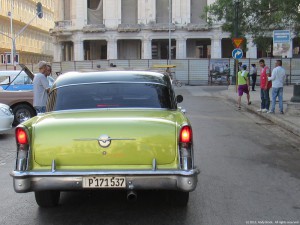 We were there with a group sponsored by the Spoleto Festival and went to museums, art galleries and music performances every day. We met artists and performers and found them all friendly, engaging and talented. The only downside was my lack of understanding of being able to bring back some of that seven-year-old Havana Club rum. Good stuff. Anne and I slipped over to the Hotel Nacional one evening and sat on the patio overlooking the Malecon and sipped the best daiquiris ever. Thanks for evoking fond memories.
We were there with a group sponsored by the Spoleto Festival and went to museums, art galleries and music performances every day. We met artists and performers and found them all friendly, engaging and talented. The only downside was my lack of understanding of being able to bring back some of that seven-year-old Havana Club rum. Good stuff. Anne and I slipped over to the Hotel Nacional one evening and sat on the patio overlooking the Malecon and sipped the best daiquiris ever. Thanks for evoking fond memories.
— Ben Moise, Charleston, S.C.
Enchanted by Cuba
To the editor:
We totally agree with what you have said. We visited Cuba in early March with a group and were enchanted. Loved it. Do not want too many changes to take place, though perhaps opportunities for improvement for the lives and comfort of the Cuban people who were quite wonderful. Our private tour focused on the Jewish community past and present on the island and was most fascinating. Most of us were from the Charleston area.
— Susan Wallen, Mount Pleasant, S.C.
- Send us a letter. If you have an opinion on something we’ve offered or on a subject related to the Lowcountry, please send your letters of 150 words or less to: editor@charlestoncurrents.com. Our feedback policy.
Sept. 7+: New show, dancing, Green Fair
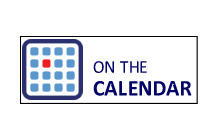 (NEW) PURE Theatre show: Sept. 11 to Oct. 2, 477 King Street, Charleston. The theatre will offer the southeastern regional premier of Gina Gionfriddo’s critically-acclaimed comedy, “Rapture, Blister, Burn,” at 3 p.m. or 7:30 p.m. (check the website for more details).
(NEW) PURE Theatre show: Sept. 11 to Oct. 2, 477 King Street, Charleston. The theatre will offer the southeastern regional premier of Gina Gionfriddo’s critically-acclaimed comedy, “Rapture, Blister, Burn,” at 3 p.m. or 7:30 p.m. (check the website for more details).
Shaking a leg. It’s the end of the season for dancing at county parks with the summer’s last Shaggin’ on the Cooper on Sept. 12 and the final version of a Moonlight Mixer at the Folly Beach Pier set for Sept. 18. At each, a DJ will spin great old tunes to keep your feet moving. Click here for more.
Charleston Green Fair: Noon to 5 p.m., Sept. 20, James Island County Park. The 8th annual fair will offer lots of ways to learn about sustainability in day-to-day life. It will feature games, exhibits, contests, fitness opportunities, musical entertainment and much more. Admission is free with $1 gate admission. More.
Author visit: 5 p.m., Sept. 21, Blue Bicycle Books, 420 King St., Charleston. Author Lee Robinson will read from her debut novel, “Lawyer for the Dog,” which is set in Charleston where she worked for years as a lawyer and was the first woman president of the Charleston County Bar Association. She now lives in Texas. More: BlueBicycleBooks.com
(NEW) Workplace diversity: 9 a.m. to 4 p.m., Sept. 25, School of Professional Studies, College of Charleston, 3800 Paramount Road, North Charleston. The College of Charleston, The Citadel, MUSC and Denny’s are partners in a new, day-long initiative to bring together community leaders to advance the management of diversity. Register: go.cofc.edu/advancingdiversity
Chase After a Cure golf tournament: Sept. 25, Patriots Point Links, Mount Pleasant. The fourth annual Drive Away Childhood Cancer Golf Tournament will benefit Chase After a Cure, a Summerville nonprofit that funds childhood cancer research and raises awareness. Since 2009, the group has raised almost $1 million for research and equipment at MUSC. $400 a foursome. More info: http://www.chaseafteracure.com
Oktoberfest 5K Run-Walk: 9 a.m., Sept. 26, Laurel Hill County Park, Mount Pleasant. The East Cooper Breakfast Rotary Club will host this annual benefit trail run that features a German band, brats and a Bavarian beer garden to welcome participants to the finish line. Costumes encouraged. Learn more and register here: http://oktoberfest5k.net/
Latin American Festival: 11 a.m. to 6 p.m., Oct. 4, Wannamaker County Park, North Charleston. The 24th edition of the festival will feature sensational sounds and vibrant performances from seven acts, including a 12-piece salsa band and urban group from Miami. Dance, art, food and children’s activities are also available at the event, which has an entry fee of $10 per person, with discounts to children, college students, seniors and military. More: CharlestonCountyParks.com
(NEW) Polo: 11:45 a.m. to 6 p.m., Oct. 11, Sandcastle Community Center, 1 Shipwatch Road, Kiawah Island, S.C. The Kiawah Cares Foundation will host the inaugural Kiawah Cup Beach Polo invitational on the beach as a new fundraiser. To learn more about tickets, which now are on sale, go to: KiawahCup.org
Bird walks: 8:30 a.m. to noon, every Wednesday and Saturday. This is the time of year that a great variety of migrating birds fly through the Lowcountry so what better time to take part in one of the regular early morning bird walks at Caw Caw Interpretive Center in Ravenel. Pre-registration is suggested. Cost is $5. Walks also are conducted on James Island and Folly Beach. Learn more online.
If you have an event to list on our calendar, please send it to editor@charlestoncurrents.com for consideration. The calendar is updated weekly on Mondays.
REVIEWFactory Man
How One Furniture Maker Battled Offshoring, Stayed Local — and Helped Save an American Town
Nonfiction by Beth Macy
![]() The Bassett Furniture Company, once the world’s largest wood furniture manufacturer, was run by the same powerful Virginia family for generations. The first waves of Asian competition hit in the early 1980s, and the Bassett Company followed the trends in sending jobs overseas. Production was subsidized by the Chinese government to help sell furniture for less than it took to make it, and when prices went up in China, work would be sent to countries like Bangladesh so they didn’t have to pay higher wages. Workers were paid next-to-nothing and experienced deplorable working and living conditions.
The Bassett Furniture Company, once the world’s largest wood furniture manufacturer, was run by the same powerful Virginia family for generations. The first waves of Asian competition hit in the early 1980s, and the Bassett Company followed the trends in sending jobs overseas. Production was subsidized by the Chinese government to help sell furniture for less than it took to make it, and when prices went up in China, work would be sent to countries like Bangladesh so they didn’t have to pay higher wages. Workers were paid next-to-nothing and experienced deplorable working and living conditions.
A family dispute and disagreement over corporate practices led third generation factory man John Bassett III, known as JB III, to leave family ties behind and take over his wife’s family business, the Vaughn Bassett Furniture Company. Hoping to create an alternative American business model, JB III used legal maneuvers and factory efficiencies, resulting in the employment of more than 700 Virginians and the generation of sales profits in the millions.
Beth Macy, a journalist for the Roanoke Times, brings to life John Bassett III’s deeply personal furniture and family story, along with a host of characters from an industry as cutthroat as it is colorful.
– Connie Darling, Edgar Allan Poe Branch Library, Sullivan’s Island, S.C.
![]() Find this and similar titles from Charleston County Public Library. This item available as a book. To learn more or place a hold, visit www.ccpl.org or call 843-805-6930.
Find this and similar titles from Charleston County Public Library. This item available as a book. To learn more or place a hold, visit www.ccpl.org or call 843-805-6930.
Old bricks, old gate
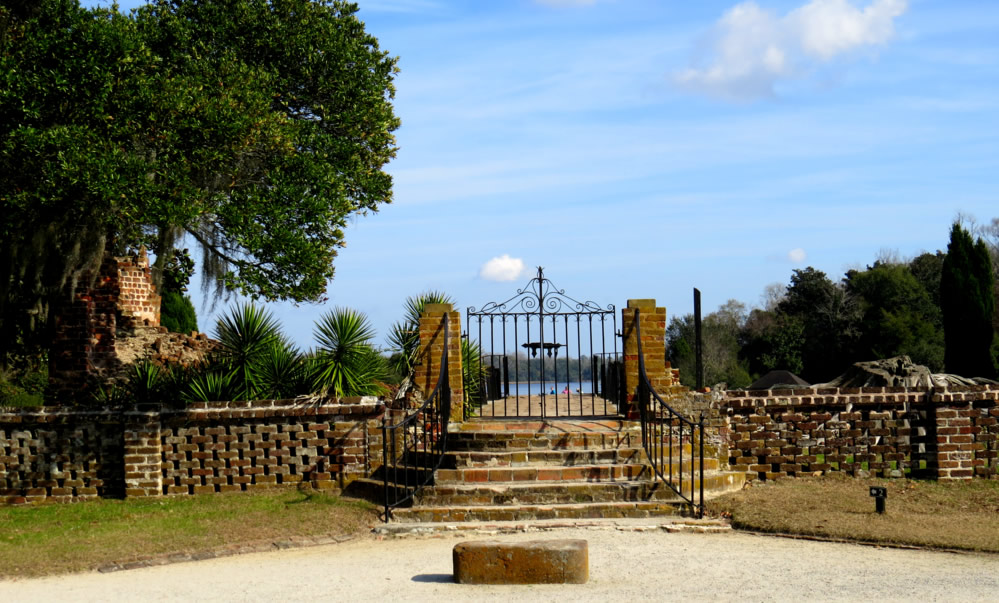 You might have been here at one point in your life, but can you remember where it is based on this photo? Send your guess — and your hometown — to editor@charlestoncurrents.com.
You might have been here at one point in your life, but can you remember where it is based on this photo? Send your guess — and your hometown — to editor@charlestoncurrents.com.
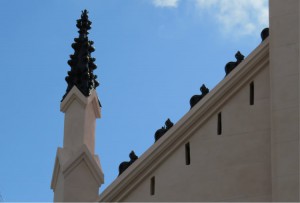 Only two people correctly identified last issue’s mystery as being the French Huguenot Church at 136 Meeting Street. Congratulations to Kristina Wheeler of West Ashley, who agreed that the features in the pictures did, indeed, look like snails, and Chris Brooks of Mount Pleasant. The current church was completed in 1845, but severely damaged during the Civil War and the earthquake of 1886. More.
Only two people correctly identified last issue’s mystery as being the French Huguenot Church at 136 Meeting Street. Congratulations to Kristina Wheeler of West Ashley, who agreed that the features in the pictures did, indeed, look like snails, and Chris Brooks of Mount Pleasant. The current church was completed in 1845, but severely damaged during the Civil War and the earthquake of 1886. More.
- Both photos are by contributing photographer Michael Kaynard of Charleston. More: KaynardPhotography.com
- If you have a picture with which you’d like to stump our readers, send it along to editor@charlestoncurrents.com.
HISTORY: South Carolina’s connection to Barbados
S.C. Encyclopedia | One of the enduring myths of American history is the centuries-old assertion that the thirteen original colonies were “English” colonies. While they were governed by the English, the colonies were not peopled only by individuals of English ancestry. Almost one-half of Virginia’s white population has been identified as ethnically English. New York, often cited as having one of the more heterogeneous colonial populations, was some forty-four percent English. For all of the colonies in what would become the United States, on average nearly fifty-eight percent of the European settlers were of English descent.
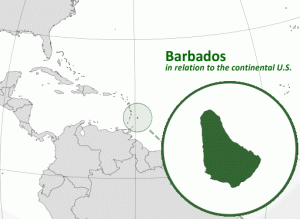 South Carolina was far below the colonial average and had one of the most diverse populations in British North America. For more than two-thirds of its colonial history (1706–1775), settlers of European extraction were a minority of the population. And within the European minority, no single nationality was a majority. Persons of English descent were the largest European ethnic group, comprising some 36.7 percent of the white population. Except for Pennsylvania, this was the smallest English population (in terms of percentage) in the thirteen colonies. Just as the European population was diverse, so were the origins of the colony’s English settlers.
South Carolina was far below the colonial average and had one of the most diverse populations in British North America. For more than two-thirds of its colonial history (1706–1775), settlers of European extraction were a minority of the population. And within the European minority, no single nationality was a majority. Persons of English descent were the largest European ethnic group, comprising some 36.7 percent of the white population. Except for Pennsylvania, this was the smallest English population (in terms of percentage) in the thirteen colonies. Just as the European population was diverse, so were the origins of the colony’s English settlers.
In 1670 a group of about 130 white immigrants arrived in South Carolina. Almost all were from the mother country, but a small number of English men and women were from the English islands in the West Indies. Although there were only a handful of real Barbadians in the first group of 130 settlers in 1670, during the next twenty years a majority of the whites who settled in South Carolina came from Barbados, the prosperous island colony that was often called “Little England.” While the settlers who emigrated from the islands to South Carolina were ethnically “English,” culturally they were Anglo-Caribbean—an important distinction.
In South Carolina, regardless of the islands from whence they came, they were referred to as “Barbadians.” These Anglo-Caribbeans who emigrated from the various English colonies in the West Indies—Barbados, Jamaica, Antigua, Nevis, St. Christopher’s, and Grenada—became a powerful presence in the new colony. Quickly rising to prominence, these English settlers who had spent time in the West Indies established the cultural ethos that shaped the development of the colony. The influence of the Barbadians was so pervasive that many historians consider South Carolina to be the colony of Barbados—not of England.
– Excerpted from the entry by Walter Edgar. To read more about this or 2,000 other entries about South Carolina, check out The South Carolina Encyclopedia by USC Press. (Information used by permission.)
About Charleston CurrentsOUR UNDERWRITERS
Charleston Currents is an underwriter-supported weekly online journal of good news about the Charleston area and Lowcountry of South Carolina.
- Meet our underwriters
- To learn more about how your organization or business can benefit, click here to contact us. Or give us a holler on the phone at: 843.670.3996.
OUR TEAM
Charleston Currents offers insightful community comment and good news on events each week. It cuts through the information clutter to offer the best of what’s happening locally.
- Mailing address: O. Box. 22261 | Charleston, SC 29413
Phone: 843.670.3996
Charleston Currents is provided to you twice a week by:
- Editor and publisher: Andy Brack, 843.670.3996
- Contributing photographer: Michael Kaynard
- Contributing editor, real estate: Doug Holmes
- Contributing editors, seniors: Catherine LaFond, Mary Ross McQuage
- Contributing editor, money: Kyra Morris
- Contributing editor, Palmetto Poem: Marjory Wentworth
SUBSCRIBE FOR FREE
Subscriptions to Charleston Currents are free.
- Click here to subscribe.
- Unsubscribe. We don’t want to lose you as a reader of Charleston Currents, but if you must depart, please click here.


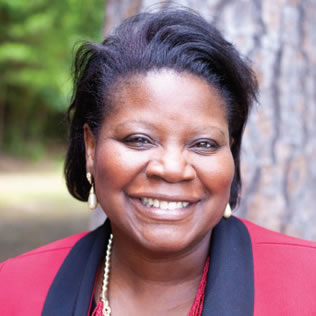

 We Can Do Better, South Carolina!
We Can Do Better, South Carolina!
























